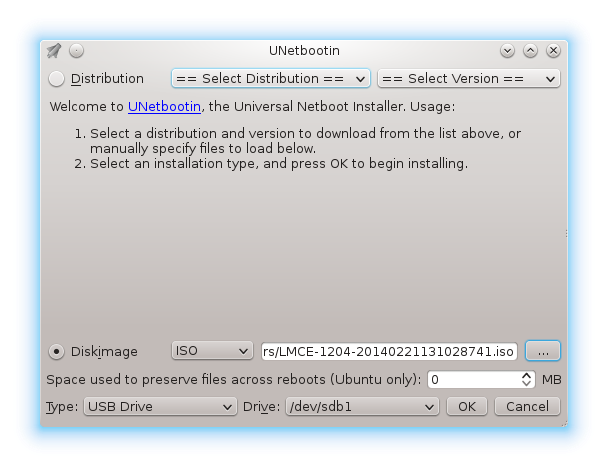USB+Thumb+Drive+Installation
From LinuxMCE
Installing LinuxMCE from a USB Thumb Drive (USB Flash Drive/ USB Stick)
Background
This guide explains a method of creating a bootable USB thumb drive containing the LMCE installation media. The usual method of install is to download the DVD iso installer image and burn that to a DVD. However, in order to save DVDs and for cases here optical drives aren't available or desired, a flash drive or thumb drive is an excellent alternative.
I performed these steps on a Fedora Core 17 desktop machine but I'm sure a similar approach will work on other systems.
Steps
- Download the snapshot or iso DVD image from the usual locations (http://linuxmce.iptp.org/snapshots/)
- Download the MD5 checksum and confirm that your ISO file is error free (beyond the scope of this article).
- Ensure you have unetbootin installed for your system (http://unetbootin.sourceforge.net/)
- For unetbootin to use your thumb drive, it needs to be formatted and have a FAT32 partition added to it, and then be mounted. Again, this is beyond the scope of this article but I formatted my thumb drive using the disks utility in KDE (chose compatible with all systems - MBR/DOS) and then used gparted to create a new FAT32 partition on the drive. Removing and adding the drive (and choosing "open in file manager") then causes it to be mounted by Fedora.
- Run unetbootin as root (not sure if this is essential but I did)
- Choose "Diskimag" radio button (rather than Distribution
- Browse to your downloaded iso image and select it using the elipses button [...]
- Select your usb drive if it isn't already. In my case /dev/sdb1. Note, if there is nothing to select here you need to make sure your drive is in the state described in point 4 above before running unetbootin.
- Click OK, and that's it. When done, you should have a bootable LMCE installer on your drive.
